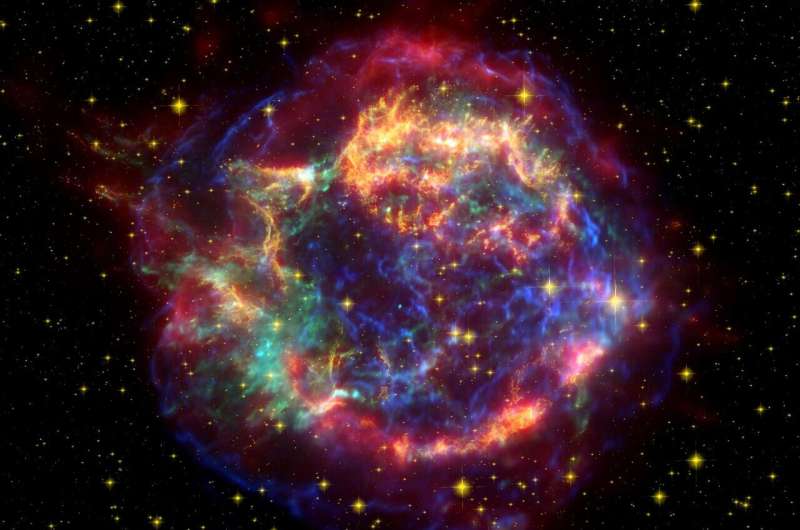
Copernical Team
Yale project brings creative expression to space flight
 Picture a spacesuit. It's functional, and the mirrored visor is fun. But you can't dance in it. While the first astronaut to set foot on Mars probably won't pirouette or perform a jazz split on the planet's rust-colored soil, folks at Yale are nonetheless thinking about how to encourage artistic expression in space exploration.
In the spring course "The Mechanical Artifact: Ultra Space," Y
Picture a spacesuit. It's functional, and the mirrored visor is fun. But you can't dance in it. While the first astronaut to set foot on Mars probably won't pirouette or perform a jazz split on the planet's rust-colored soil, folks at Yale are nonetheless thinking about how to encourage artistic expression in space exploration.
In the spring course "The Mechanical Artifact: Ultra Space," Y Fleet Space' Exosphere Earth Scanning Technology tested at lithium exploration site
 Fleet Space Technologies is delighted to announce the successful completion of a trial using its proprietary Ambient Noise Tomography (ANT) technology to faster and non-invasively find critical lithium deposits.
This was commissioned by Australia's newest lithium miner, Core Lithium, at its Finniss Project in Australia's Northern Territory. This is in line with its mission to provide the g
Fleet Space Technologies is delighted to announce the successful completion of a trial using its proprietary Ambient Noise Tomography (ANT) technology to faster and non-invasively find critical lithium deposits.
This was commissioned by Australia's newest lithium miner, Core Lithium, at its Finniss Project in Australia's Northern Territory. This is in line with its mission to provide the g HKATG tooling up for satellite mass production
 Hong Kong Aerospace Technology Group Limited (01725. HK), which is committed to promoting Hong Kong's industrialization and supporting Hong Kong's becoming an international innovation and technology hub announced on 2 August 2022 that HKSML, its indirect wholly-owned subsidiary entered into a fit-out contract regarding the 2/F and 8/F Advanced Manufacturing Centre (AMC) in Tseung Kwan O. The con
Hong Kong Aerospace Technology Group Limited (01725. HK), which is committed to promoting Hong Kong's industrialization and supporting Hong Kong's becoming an international innovation and technology hub announced on 2 August 2022 that HKSML, its indirect wholly-owned subsidiary entered into a fit-out contract regarding the 2/F and 8/F Advanced Manufacturing Centre (AMC) in Tseung Kwan O. The con Intelsat and OneWeb partnership brings multi-orbit connectivity to airlines worldwide
 Leading satellite communications companies OneWeb and Intelsat have signed a global distribution partnership agreement to offer airlines a seamless inflight connectivity (IFC) solution with the best combination of performance, coverage, and reliability on the market.
The partnership enables Intelsat to distribute OneWeb's ground-breaking low Earth orbit (LEO) satellite services to airlines
Leading satellite communications companies OneWeb and Intelsat have signed a global distribution partnership agreement to offer airlines a seamless inflight connectivity (IFC) solution with the best combination of performance, coverage, and reliability on the market.
The partnership enables Intelsat to distribute OneWeb's ground-breaking low Earth orbit (LEO) satellite services to airlines Antaris close seed funding round to accelerate development of software solutions for space
WVU space robotics research helps Mars rovers find their footing
 West Virginia University scientists have developed a way for extraplanetary rovers to use nonvisual information to maneuver over treacherous terrain. This research aims to prevent losses like that of the Martian exploration rover Spirit, which ceased communications after its wheels became trapped in invisibly shifting sands in 2010.
Space roboticist Cagri Kilic, a Statler College of Engine
West Virginia University scientists have developed a way for extraplanetary rovers to use nonvisual information to maneuver over treacherous terrain. This research aims to prevent losses like that of the Martian exploration rover Spirit, which ceased communications after its wheels became trapped in invisibly shifting sands in 2010.
Space roboticist Cagri Kilic, a Statler College of Engine Artemis I to launch first-of-a-kind deep space biology mission
 Poised to launch on Artemis I from NASA's Kennedy Space Center in Florida, BioSentinel - a shoebox-sized CubeSat - will perform the first long-duration biology experiment in deep space. Artemis missions at the Moon will prepare humans to travel on increasingly farther and longer-duration missions to destinations like Mars, and BioSentinel will carry microorganisms, in the form of yeast, to fill
Poised to launch on Artemis I from NASA's Kennedy Space Center in Florida, BioSentinel - a shoebox-sized CubeSat - will perform the first long-duration biology experiment in deep space. Artemis missions at the Moon will prepare humans to travel on increasingly farther and longer-duration missions to destinations like Mars, and BioSentinel will carry microorganisms, in the form of yeast, to fill Europe Ready For Artemis
 Video:
00:03:26
Video:
00:03:26
ESA and NASA are working hand in hand before the first Artemis mission to the Moon through a series of joint mission simulations. Teams based at the Erasmus Support Facility (ESF) at ESA’s ESTEC facility in The Netherlands, the German Space Operations Centre at ESA’s Columbus Control Centre in Oberphfaffenhofen and NASA’s Johnson Space Center in Houston are combining their expertise in a series of exercises to ensure a successful launch.
When it comes to simulations, it’s important that not everything goes perfectly right as it recreates - in real time - different stages of the mission to
Want to colonize Mars? Talk to this outer space anthropologist first

Maybe infinity and beyond should wait.
Prominent physicists and wealthy tycoons envision life scattered across the solar system. Elon Musk wants humans to become a multiplanetary species. Jeff Bezos pictures floating space colonies home to billions.
Simulated-gravity ecosystems powered by the sun.
Rocket launch to image supernova remnant

A Northwestern University astrophysics team is aiming for the stars—well, a dead star, that is.
On Aug. 21, the NASA-funded team will launch its "Micro-X" rocket from White Sands Missile Range in southern New Mexico. The rocket will spend 15 minutes in space—just enough time to snap a quick image of supernova remnant Cassiopeia A, a star in the Cassiopeia constellation that exploded approximately 11,000 light-years away from Earth. Then, the rocket will parachute back to Earth, landing in the desert—about 45 miles from the launchpad—where the Northwestern team will recover its payload.
Short for "high-resolution microcalorimeter X-ray imaging rocket," the Micro-X rocket will carry a superconductor-based X-ray imaging spectrometer that is capable of measuring the energy of each incoming X-ray from astronomical sources with unprecedented accuracy.
"The supernova remnant is so hot that most of the light it emits is not in the visible range," said Northwestern's Enectali Figueroa-Feliciano, who leads the project. "We have to use X-ray imaging, which isn't possible from Earth because our atmosphere absorbs X-rays. That's why we have to go into space.
